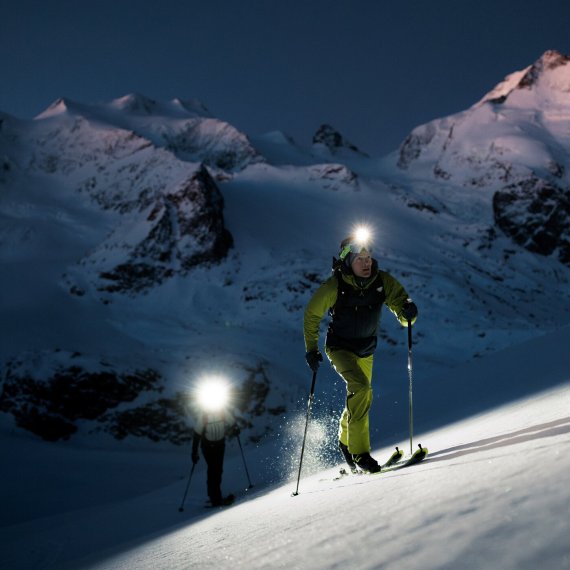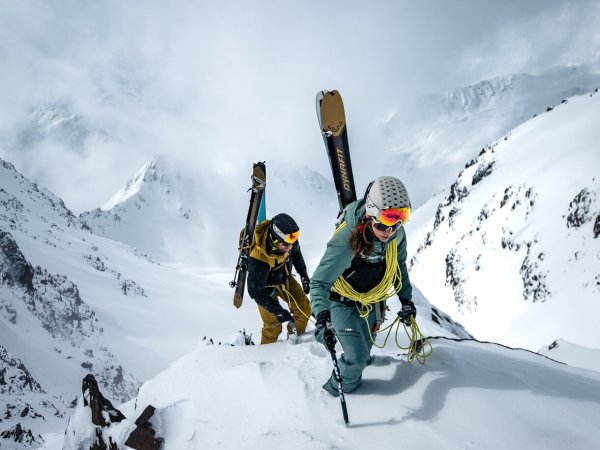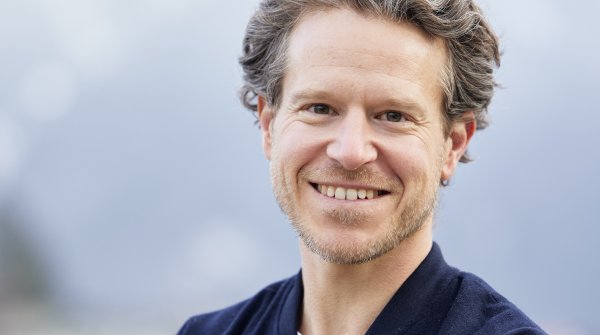Save the Date:
🎤 Panel Talk: Dynafit: From the Mountain to the Olympic Stage
👥 Speaker: Alexander Nehls, Lena Haushofer, Katharina Kleinfeldt
📍 Location: House of Content
🗓️ Date: December 01, 2025
⏰ Time: 11:00-11:15
The talk is part of Media Monday, which brings together the most important trends and voices in the industry in one morning:
🔭 Global developments & challenges in sports
🏅 Inspiration surrounding the Olympic Games
📊 Insights into ISPO 2025/26
🤝 Exchange & get-together at the end
Skeleton mixed team, women's luge doubles, ski freestyle dual moguls or women's ski jumping from the large hill - there are a lot of new events at the Winter Olympics in Milan and Cortina (February 6 to 22, 2026). However, the most spectacular premiere will undoubtedly be the ski mountaineering competitions - also known as SkiMo or ski mountaineering - on the legendary Stelvio downhill run in Bormio. This is exactly where the alpine skiers will determine their Olympic downhill champion.
This is not really an Olympic premiere for ski mountaineering. Military patrol runs on skis were already part of the program at the first Winter Olympics in Chamonix in 1924 and for the last time in St. Moritz in 1948. This was a kind of mixture of biathlon and ski mountaineering. In summer 2021, the International Olympic Committee (IOC) announced that pure ski mountaineering would be a new addition to the competition calendar at the 2026 Winter Olympics in Milan and Cortina. Three Olympic gold medals will be awarded: In the men's and women's sprint and the mixed relay.

The high-speed downhill run at speeds of up to 150 km/h is traditionally one of the absolute highlights of the Winter Games. What role will ski mountaineering play on the biggest stage in world sport and what consequences will this have for the sports industry? This is exactly what will be discussed at Media Monday on December 1 at ISPO Munich. "This is a very exciting question that we ask ourselves every day," says Alexander Nehls in an interview with ISPO.com. So the answer is not easy even for the Global Marketing Director of SkiMo market leader Dynafit.
The first impulse is obvious: Hundreds of millions of TV viewers at the Olympics all over the world ensure a rapid increase in awareness of the sport and a real boom. Just like beach volleyball, for example, which celebrated its premiere at the 1996 Summer Olympics in Atlanta. The perfect mix of sport, sun, sand, sound and sex appeal has long since become a permanent trend; at the 2024 Olympic Games in Paris, the best players played against the dream backdrop of the Eiffel Tower. Sport climbing, which has been an Olympic sport since Tokyo 2021, has also sparked a growing global interest in this spectacular outdoor and indoor sport.
In ski mountaineering, the forecast is not so easy because the show at the Olympics does not have much to do with the origin of the sport. "You run a lot of vertical meters into the mountains. Maybe three or four peaks, long ascents, great descents. It often takes several hours," says Nehls. At the Olympic premiere in Bormio, all of this will be condensed into just a few minutes. "Because it had to be suitable for television, of course, a new format was invented. To be honest, the SkiMo sprint is a sport - just like speed climbing - that nobody really does outside of competitive sports," says the expert.
On a course, the athletes have to master all the elements of the original ski touring sport in the shortest possible time - i.e. ascent with skins under the skis, carrying passages and descents. The races are held in a knockout format with several athletes, so the first to finish is also the winner. This makes the format easy to understand for TV viewers.
However, this has little to do with the reality for the average ski tourer: "The top athletes need seven seconds to change skins, the average ski tourer needs 15 minutes," says Alexander Nehls. That's why two hearts are beating in his chest: "I'm really happy for the athletes that it's an Olympic event, because they finally deserve the big stage. On the other hand, not all spectators will probably immediately understand what they are doing at the Olympics in such a short space of time. But that's the pill we have to swallow in order to get this big stage. The question remains: Will the transfer to our beautiful, original winter sport succeed?"

It is precisely this question that will also decide what impact the Olympic premiere will have on the sports industry. "I'm excited," says Alexander Nehls. Some days, the marketing manager thinks that "nobody outside of our mountain sports bubble will be interested, because very few people actually know that you can go up the mountain with skins under your skis. The sport is just niche." Nehls cites figures to put this into perspective: Around 600,000 people could be described as passionate ski tourers who do at least 15 tours a year. Of these, 80 percent are hobby skiers. The sport is also comparatively expensive, especially at the top end: "Skis cost around 1,200 euros, boots 2,000 euros and bindings 600 euros for racing. That's not something you just buy straight away and say. 'I would give it a try'."
On the other hand, ski touring is a growth area in times of uncertain snow conditions because mountain enthusiasts can react more flexibly to the conditions. That's why Nehls sometimes thinks that the Olympic premiere could be the start of something big: "Sports like biathlon are also very artificial and are still experiencing a lot of hype. That's why I have a little hope that it will establish itself, that it will be on the longlist for the Olympics and then maybe even become a relevant sport at some point." It's important to note that ski mountaineering was initially only included in the program for the 2026 Winter Olympics. However, the chances for the following Winter Games in France in 2030 are also quite good, as the country, like Italy, is one of the absolute supporters of the sport.
Either way, Nehls does not expect the Olympic premiere for ski mountaineering to cause a huge explosion in the winter sports industry for the time being. After the steep coronavirus upswing, the market has reached saturation point and the trend is only slowly becoming positive again. Currently, the alpine ski sector is the big winner. The ski mountaineering sector will be difficult for new brands to conquer: "The investments to bring new innovations are already very high for an extremely low return." Even Dynafit doesn't make any real turnover in the racing sector: "For us, it's brand-building, we do it for the sport and it's like a Formula 1 racing team." New companies would certainly try to jump on the bandwagon at some point: "Today, however, there are already many good ones for a very manageable sized pie."
Dynafit, which is based in Kiefersfelden, is nevertheless fully committed to ski mountaineering/ski touring alongside trail running - the sector in which it generates around 60 percent of its turnover. "We are the only brand that truly equips from head to toe in this area. And we have revolutionized this traditional sport with the pin binding, for example."
Of course, this expertise could also be extended to snowboarding, cross-country skiing or even snowshoeing, but the company has made a conscious decision not to grow by expanding into other sports: "We simply want to remain true to mountain endurance sports in this form instead of opting for more sales. A brand grows through attraction and not through expansion. We want to continue to polarize and remain true to ourselves. The aim is not to scale up to the extreme right now. At some point, you're no longer trendy and then it's over. This is a very conscious brand decision."
Save the Date:
🎤 Panel Talk: Dynafit: From the Mountain to the Olympic Stage
👥 Speaker: Alexander Nehls, Lena Haushofer, Katharina Kleinfeldt
📍 Location: House of Content
🗓️ Date: December 01, 2025
⏰ Time: 11:00-11:15
The talk is part of Media Monday, which brings together the most important trends and voices in the industry in one morning:
🔭 Global developments & challenges in sports
🏅 Inspiration surrounding the Olympic Games
📊 Insights into ISPO 2025/26
🤝 Exchange & get-together at the end
However, this does not mean that Dynafit does not want to take advantage of the potential boom effects of the Olympic premiere. In order to take advantage of the tailwind, Nehls can imagine, for example, organizing ski mountaineering events close to the potential audience in the future. Whether that be close to the company headquarters in Kiefersfelden or on the Olympic mountain in Munich. In October, the biathletes' Loop One Festival in Munich's Olympic Park with tens of thousands of spectators showed what a boost this can provide.

- ISPO awards
- Mountain sports
- Bike
- Design
- Retail
- Fitness
- Health
- ISPO Job Market
- ISPO Munich
- ISPO Shanghai
- Running
- Brands
- Sustainability
- Olympia
- OutDoor
- Promotion
- Sports Business
- ISPO Textrends
- Triathlon
- Water sports
- Winter sports
- eSports
- SportsTech
- OutDoor by ISPO
- Heroes
- Transformation
- Sport Fashion
- Urban Culture
- Challenges of a CEO
- Trade fairs
- Sports
- Find the Balance
- Product reviews
- Newsletter Exclusive Area
- Magazine



